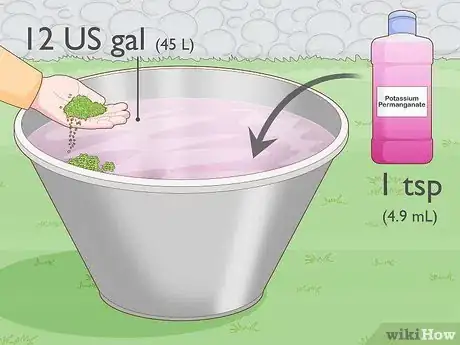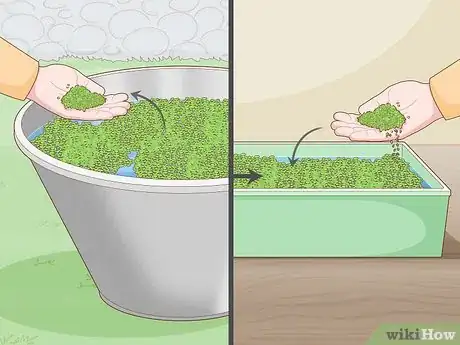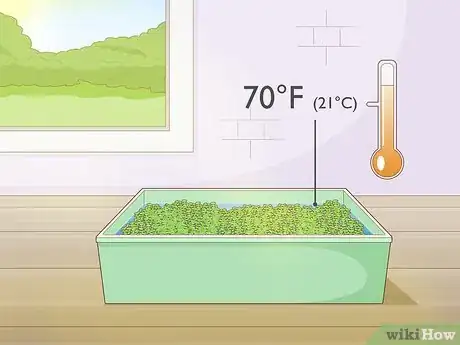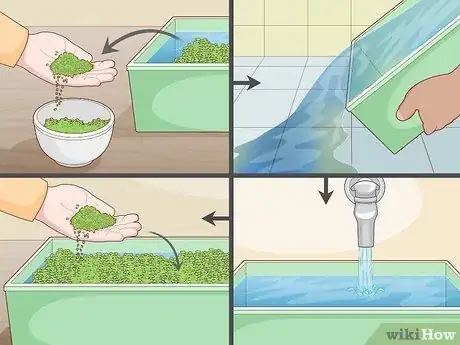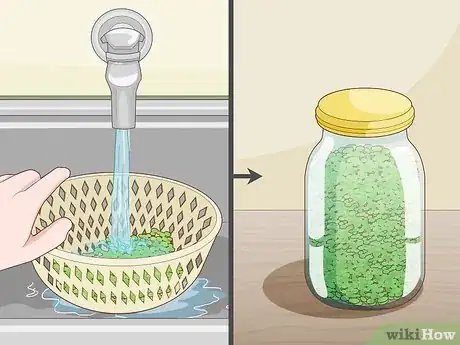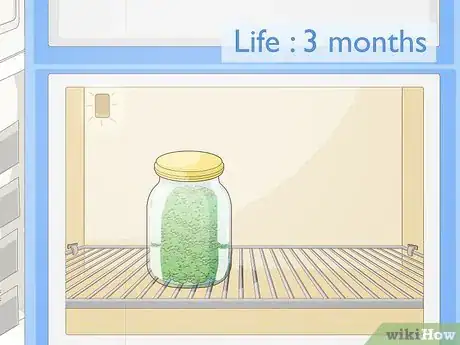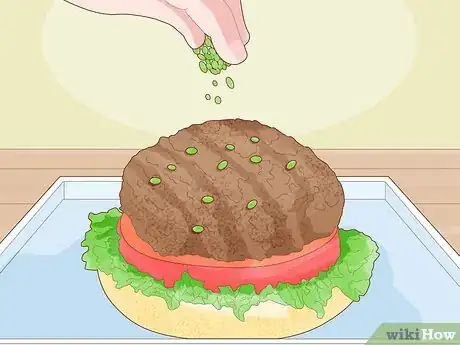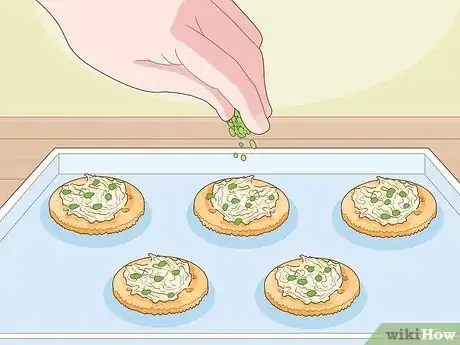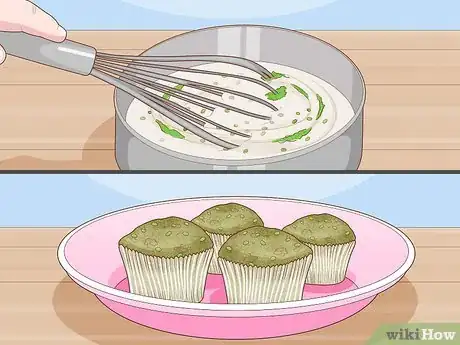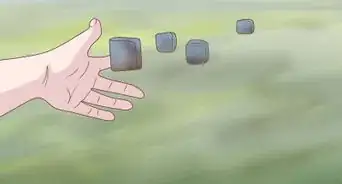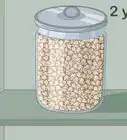This article was co-authored by wikiHow staff writer, Janice Tieperman. Janice is a professional and creative writer who has worked at wikiHow since 2019. With both a B.A. and M.A. in English from East Stroudsburg University, she has a passion for writing a wide variety of content for anyone and everyone. In her free time, you can find her working on a new crochet pattern, listening to true crime podcasts, or tackling a new creative writing project.
This article has been viewed 12,942 times.
Learn more...
If you’ve ever passed by a pond or a lagoon, you’ve probably seen duckweed before. This small, green plant is a popular food for ducks and fish, but it can also pack a nutritious punch for people, as well.[1] Although it may seem a little unconventional, it doesn’t take long to set up a nourishing growing space in your home for your own duckweed plants, which you can eventually use in your own recipes.
Steps
Sterilizing and Planting Duckweed
-
1Scoop out some duckweed from a pond or buy some at a store. Visit a nearby pond or lagoon and see if you can find any duckweed growing there. Use a skimmer or net to fill a large bag or container with duckweed so you can easily bring it home with you. If you don’t live near a pond or any standing water, check your local pet store and see if it sells duckweed.[2]
- Duckweed is a common aquarium food, so you can probably find it at any store that sells fish keeping supplies.
-
2Sanitize any harvested duckweed with potassium permanganate. Fill a large bucket or basin with 12 US gal (45 L) of water, then mix in around 1 tsp (4.9 mL) of potassium permanganate. Soak the duckweed in the sanitizing solution for 10 minutes, then rinse it off with clean water.[3]
- Your sanitizing mixture should be around 0.1% potassium permanganate. You can find this substance at most home improvement stores.
- If you’re working with store bought duckweed, you don’t have to worry about this.
Advertisement -
3Fill several trays with warm tap water. Set aside several trays, depending on how much duckweed you plan on growing. Ideally, use plastic trays that are at least 12 in (30 cm) deep, so your duckweed has plenty of water to soak in. Fill these trays completely with tap water so your duckweed has a place to grow.[4]
- Duckweed is very light and floats on the surface, so you don’t need to worry about any water displacing. If you’re planning on growing a lot of it, set up multiple trays ahead of time.
- Since duckweed is a freshwater plant, only use freshwater to grow it.
- Try to add water that’s about 70 °F (21 °C).[5]
-
4Move the duckweed into the water-filled trays. Use your hands or a clean skimmer to scoop and arrange your duckweed on the surface of the trays. Try to cover the entire surface of each tray with the plant, if possible.
-
5Place the duckweed trays in a warm, well-lit area. Keep your trays on a sunny windowsill indoors or on a porch or deck where they’re exposed to as much sunlight as possible. Try to keep the water around 70 °F (21 °C), which is the ideal temperature for duckweed to flourish.[6]
- It’s perfectly fine if you can’t keep your duckweed in direct sunlight constantly. In a pinch, a north-facing window or skylight can help keep your plants nourished.
- You might want to find several areas with direct or partial sunlight and spread out the trays in a few different spots. That way, you can figure out where the duckweed flourishes the most and use that area in the future.[7]
-
6Replace the old water in your trays with fresh water once a week. Transfer your growing duckweed to a clean container or bowl, then pour out the leftover water from the week before. At this time, toss out any white or yellow fronds that’ve been growing in your tray.
- Since duckweed needs a lot of sunlight, there’s a good chance that some of the water will evaporate throughout the week.
Growing Alternative:
Place your duckweed trays under fluorescent light bulbs, then stir a small spoonful of table sugar into the trays. Replace the water as you usually would and stir in a tiny spoonful of sugar into the new batch. Ideally, the water and sugar should be at a 100:1 ratio.
Harvesting and Storing Duckweed
-
1Use a skimmer to harvest the duckweed when the water's surface turns green. Duckweed is ready to be harvested when the surface of the water is completely green and the duckweed is fully covering the surface of each tray. Remove the duckweed with a skimmer or spoon and transfer it to an empty colander.[8]
- It can take several days or weeks for duckweed to grow. Keep an eye on the trays and make sure they're getting plenty of sunlight.[9]
-
2Rinse off your duckweed with clean water before eating or storing it. Place your duckweed-filled colander under some running water and clean off all the fronds. Check that’s there no dirt, grime, or off-color fronds in the container as you rinse.[10]
- Yellow or white fronds are old or damaged, and aren’t ideal for eating. Toss those out if you come across them.
-
3Refrigerate the duckweed in an airtight container for up to 3 months. Find an airtight container for your duckweed if you don’t plan on using it right away. Use a label or piece of tape to mark down the current date so you can keep track of how fresh your duckweed is.[11]
Including Duckweed in Different Foods
-
1Mix duckweed into a variety of egg dishes. Cook up some steamed eggs, an omelette, or another egg dish that you enjoy a lot. Before digging in, take a spoonful of duckweed and sprinkle it over your tasty dish. It won’t add a ton of flavor to your eggs, but it’ll add some extra protein![12]
-
2Sprinkle duckweed over a hamburger or your favorite sandwich. Dress up your burger or sandwich with your usual condiments and toppings. As a special twist, switch out your lettuce for duckweed.[13]
- Since duckweed doesn’t have a lot of flavor, you can use it to top just about any sandwich!
-
3Create a tasty snack with crackers, cottage cheese, and duckweed. Lay out a plain cracker and spoon some cottage cheese on top. As an extra garnish, sprinkle a pinch of duckweed on top.[14]
- This is a great appetizer or snack food if you’re having guests!
-
4
-
5Add duckweed into batter when making sweet baked goods. Prepare your favorite baked goods as you usually would, whether it’s muffins, fried bread, or cookies. Stir in a spoonful of duckweed into the batter, then bake your sweet treat as you normally would.[17]
Things You’ll Need
Sterilizing and Planting Duckweed
- Skimmer
- Bucket
- Water
- Potassium permanganate
- Plastic trays
- Table sugar
Harvesting and Storing Duckweed
- Airtight container
References
- ↑ https://www.rutgers.edu/news/could-duckweed-feed-world
- ↑ https://fishtankmaster.com/duckweed-aquarium/
- ↑ https://www.ncbi.nlm.nih.gov/pmc/articles/PMC5812110//
- ↑ https://www.rutgers.edu/news/could-duckweed-feed-world
- ↑ https://gardenpool.org/online-classes/growing-duckweed
- ↑ https://gardenpool.org/online-classes/growing-duckweed
- ↑ https://gardenpool.org/online-classes/growing-duckweed
- ↑ https://www.rutgers.edu/news/could-duckweed-feed-world
- ↑ http://www.fao.org/ag/aga/agap/frg/lrrd/lrrd7/1/3.htm
- ↑ https://www.rutgers.edu/news/could-duckweed-feed-world
- ↑ https://www.rutgers.edu/news/could-duckweed-feed-world
- ↑ http://www.ruduckweed.org/uploads/1/0/8/9/10896289/iscdra-duckweedforum_issue16-2017-01.pdf
- ↑ https://www.rutgers.edu/news/could-duckweed-feed-world
- ↑ https://www.rutgers.edu/news/could-duckweed-feed-world
- ↑ https://www.rutgers.edu/news/could-duckweed-feed-world
- ↑ http://www.ruduckweed.org/uploads/1/0/8/9/10896289/iscdra-duckweedforum_issue16-2017-01.pdf
- ↑ http://www.ruduckweed.org/uploads/1/0/8/9/10896289/iscdra-duckweedforum_issue16-2017-01.pdf

